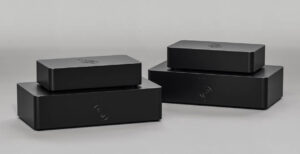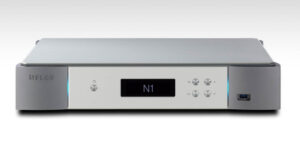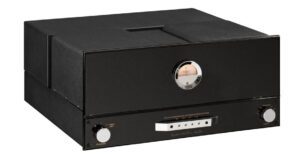
Coming after the outstanding Reference 75 stereo amp, I have to admit some reticence in taking on the Audio Research Reference 250 monos. The quality of the Ref 75 sound runs deep, and although these offer three and a bit times the power, there’s that nagging doubt that one little ‘un can beat two big ‘uns. I shouldn’t have worried.
Since acquisition by Fine Sounds, Audio Research has gone through something of a Renaissance. The Italian backers have been very clever with this brand, by not shaking the tree too hard, they seem to have brought the best out of Audio Research’s core values, making products that Audio Research was always good at building, with what seems like a lot of additional R&D budget to realise their potential.
The Ref 250 monos replace the popular Ref 210s. They continue the broad move by Audio Research to switch from 6550 power tubes to KT120s, with each chassis containing three matched pairs as power output tubes, a further matched pair of KT120s as line drivers, two 6H30s (one gain stage and one regulator) and a 6550C as regulator. As a result, you end up with a tube amp capable of around 0.5% distortion at 250W. Audio Research has never been a great proponent of low or no negative feedback in its power amp designs (because you sacrifice output impedance and damping factor, as well as generally giving better measurement on the bench), and the Reference 250 is no exception, with a healthy 8.8% global feedback across the circuit.
This also means an amplifier that creates quite a draw on your electrical supply. The 20A IEC socket isn’t just there for show; the 380W ‘idle’, the 770W at rated output and the 1kW flat out power requirements per side mean it’s probably best to have something more than a 13A circuit behind the wall socket, especially if you are driving these babies as close to full throat. Yet it draws a green(ish) 1W in its ‘off’ setting.
As ever with the best in ARC, this is balanced-only operation, with a heavy duty XLR socket sitting above the rear-firing (and quiet) case fan. Below that is a solid terminal block for four, eight and 16 ohm speaker systems, and there’s a set of 12V trigger phono terminals for automated power up.

The front panel echoes the Reference 75 and has more in common with classic ARC designs than the green fluorescent display of its predecessor. Each Ref 250 has a large central VU meter, which can double as power indicator and tube biasing indicator. You can turn the fan and the meter and or its pale blue glow off from the front panel.
It’s a Reference class product and as such should be used with Reference grade electronics. We used it with the good-as-it-gets Reference 10 two-box line preamp (see box) – this is a truly spectacular combination with a price tag to match. We played them through a variety of loudspeakers at first, but the sessions quickly ended with the new Wilson Audio Duette 2 standmounts, a combination that is possibly amplifier overkill, but really shows what both the Wilsons can do and what the Reference 250 can bring out of a loudspeaker. Although the four-ohm tap is perhaps the right one electrically, I found the eight to be slightly better feeding these speakers. As ever, experimentation and empiricism reign supreme.
Here’s the best way of thinking through the Reference 250. Devote an afternoon to the installation. You’ll spend that long taking the amps out of the boxes, fitting the tubes, biasing the tubes, making sure all your ducks are in a row with regard to cabling and the rest. Then, when all the pre-flight checks are complete, fire them up. Give yourself about an hour, by which time the temperature in most rooms will have increased by about a degree or so. Then listen.
It might seem like a few minutes have elapsed, but seemingly soon after you begin the ‘then listen’ process, your worried family members will be kicking down the door wondering if you are still alive. You might find you need a shave. Hours have passed and you were blissfully unaware of it, because you were caught up in the music. The same happens the next night, and the night after that.
There’s a long break-in period suggested by ARC. You’ll clock up those hours very quickly.
What you get from the outset is very much classic Audio Research fare – a midband and soundstaging that set the benchmark for ‘to die for’ coupled with effortless, controlled bass and dynamic range and the kind of high-frequency performance that invites you to lose hours in your music. And this just seems to get better the more you listen. This isn’t the amplifier for those who micromanage their music, listening to a collection of sounds to determine whether the triangle player was playing left-handed. Oh, it can do all that analysis stuff very well should you so require, but those drawn to this kind of sound don’t tend to demand that sort of musical evisceration. This is music presented as big picture. You take in the whole of the sound in one big gulp here. And it’s a heady wine.
The ‘why’ it’s so good is an almost impossible thing to pin down. It just sounds good with every track. It puts a smile on your face and a tear in your eye. Bad recordings still sound bad, but it extracts the musical mussel from the shell all the same. It doesn’t glare, it doesn’t shine, it doesn’t add weight or slim down the sound. It might not be the quickest sounding amplifier out there, but that doesn’t seem to matter when you are this engrossed in the music.
I have to admit I’m struggling here. This isn’t just an excellent amplifier, it’s an outstanding conveyor of music. It’s just… when I try to explain that in print, I fail to get it across. When I look at my listening notes, they are like a Wiki page on the band or soloist or orchestra I was listening to at the time. They say nothing at all about the amp performance – and maybe that’s it. This is the finest expression of the ‘I know it when I hear it’ school of good music making, and if you slot these into a good system, you’ll understand not only precisely what I mean, but also why any attempt at describing that ends up as word-salad. This isn’t beyond the limits of what’s possible, but it might just be beyond the limits of what’s possible to describe.
All that being said, for some of us in European homes – and I have to admit, myself included – the Reference 75 hits the spot, and the jump to the Reference 250 might be more than you need. ‘Some’ is not ‘all’ however, and there are rooms and loudspeakers that demand more heft than the Reference 75 can bring. But that just shows both how good and how consistent this range is now proving. The Reference 250 manages to combine the grace and charm of the 75 with the kind of earthmover grunt that’s needed to make some speakers and rooms come to life.
Outstanding. Truly outstanding.
Reference 10 preamp
To show what the Reference 250 could do, it came with the two-box £27,500 Reference 10 line preamplifier. Following in the footsteps of the company’s Reference Anniversary preamplifier, it divides the circuit into balanced and single-ended line stage and separate power supply, fed by two large connectors, separating high and low voltage supplies for each channel.
Unlike all previous ARC products, the logo is set asymmetrically and the hard button count is low, everything being passed over to the large touch screen panel. Under the clear top panel, the completely dual mono zero-feedback design uses custom caps and enough energy storage and a valve roll-out that wouldn’t disgrace most power amps.
This is not meant as a review of the Reference 10, more an example of what Audio Research is capable of when cost is no object. And the short, simple answer is ‘a hell of a lot’. Or more accurately ‘not a lot’, because this is a preamp that highlights the sins of commission in other preamps. It’s perhaps the most honest – without being brutally honest – preamp out there, letting the music flow untouched by the electronics to an uncanny degree. Once again, it has the usual ARC qualities of huge soundstage and midrange openness, but seems to apply those qualities across the board.
If I were to sum up the Reference 10 in a single word, that would be ‘realistic’. It delivers musical content with a sense of realism and honesty and accuracy that should be possible at all levels, but immediately shows just how much more there is on offer from our musical sources. There’s an uncanny sense of tonal, textural and timbral ‘rightness’ on offer here; instruments just sound like the real deal here. Not dynamically compressed or electronically processed, but in some respects the only way to understand precisely what I mean is to walk a mile in the Reference 10s shoes. Once you hear what the Reference 10 does with such musical elements, you realise just how much of a bottleneck the preamp can be, and how truly remarkable the sound can be when that bottleneck is taken away. As it is through the Reference 10.
The issue is, can cost ever be no object when a preamp costs as much as the Reference 10? We are in the upper atmosphere of audio here, and few of these products make it to this level without being extremely good at what they do. The Reference 10 is no exception – it’s quite simply the best preamplifier I have encountered in all manners. I’ve heard ones that might come close in one or two parameters, but fail with others (a preamp that sounds remarkable for two tracks then stops working, for example, or one that has excellent functionality, but need you to turn it on with a stick if you want to live). Nothing out there has this combination of ultimate performance and real-world functionality that behaves with such control and poise.
We are living in a golden age for audio, but one that requires quite a lot of gold to change hands in order to realise that potential. This is quite simply the best there is, but that comes at such a price premium that it will only ever be available to a select few with very deep pockets. This is not jealousy at work, but a desire to see audio as something more than a plaything for the super-rich.
Fortunately, while the Audio Research Reference 10 pushes the frontiers of ‘how much!?!’ technology, the company also delivers more attainable products like the new SP20 preamplifier and VSi75. I suspect these attainable products get to be as good as they are through the research that goes into making Reference 10 preamps and Reference
Technical Specifications
Power Output: 250 watts per channel continuous from 20Hz to 20kHz. 1kHz total harmonic distortion typically 0.5% at 250 watts, below .04% at 1 watt. Approximate actual power available at ’clipping’ 270 watts (1kHz)
Power Bandwidth: (-3dB points) 5Hz to 70kHz
Frequency Response: (-3dB points at 1 watt) 0.5Hz to 110 kHz
Input Sensitivity: 2.4V RMS Balanced for rated output. (25.5 dB gain into 8 ohms.)
Input Impedance: 200K ohms Balanced
Output Taps: 4, 8, 16 ohms
Output Regulation: Approximately 0.9dB 16 ohm load to open circuit (Damping factor approximately 10)
Overall Negative Feedback: 8.8dB
Slew Rate: 20 volts/microsecond
Rise Time: 1.5 microseconds
Hum & Noise: Less than 0.2mV RMS – 110dB below rated output (IHF-A weighted, input shorted, 16 ohm output)
Power Supply Energy Storage: Approximately 900 joules
Power Requirements: 105-130VAC 60Hz/260-250VAC 50Hz. 770 watts at rated output, 1000 watts maximum, 380 watts at ‘idle,’ 1 watt off
Tubes Required: 3 Matched pair KT120 (Power output V1-6); 1 Matched pair KT120 (Driver V8-9); 2 6H30 (Gain stage V7 and Regulator Driver V10); 1 6550C (Regulator V11)
Dimensions (WxDxH): 48.3×49.5×22.2 cm. Handles extend 3.8 cm forward.
Weight: 33.2 kg
Price: £24,490 per pair
Manufactured by: Audio Research
By Alan Sircom
More articles from this authorRead Next From Review
See all
Reiki Audio SuperSwitch Master Pro + Servant Pro
- Mar 27, 2024

Melco Audio N1-S38 music server
- Mar 27, 2024

Focal Utopia 2022 headphones
- Mar 27, 2024











